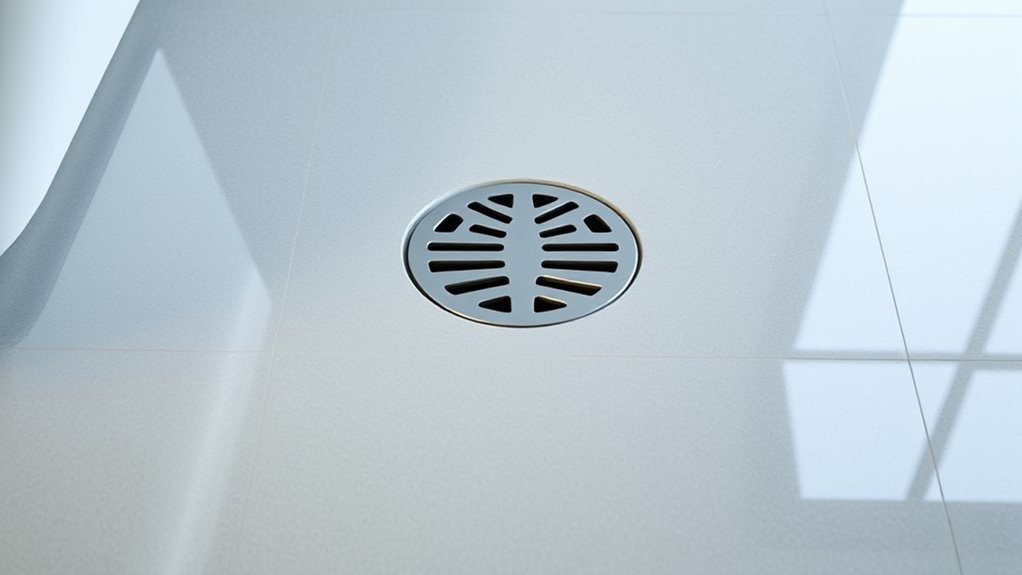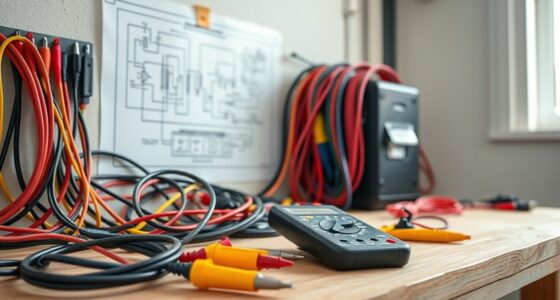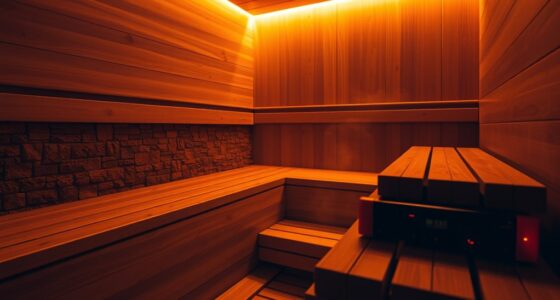To stop guessing, start with proper subfloor prep by checking moisture, leveling surfaces, and cleaning thoroughly. Choose durable materials suited to your space, and follow step-by-step installation techniques for a flawless finish. For drainage, make certain proper slope (about 1/4 inch per foot), select the right drain type for each area, and maintain systems regularly. Mastering these steps helps your flooring last longer and your drains work effectively—keep going to learn the essential details.
Key Takeaways
- Properly prepare and level subfloors to ensure durable, even flooring installation.
- Select flooring materials suited for the environment, considering moisture, traffic, and maintenance needs.
- Design and maintain correct drainage slopes (1/4 inch per foot) to prevent water pooling and damage.
- Choose appropriate drain types for each area, such as linear drains for showers or trench drains for outdoor use.
- Regularly inspect and maintain flooring and drainage systems to prevent issues and extend their lifespan.
Understanding Proper Subfloor Preparation for Long-Lasting Flooring
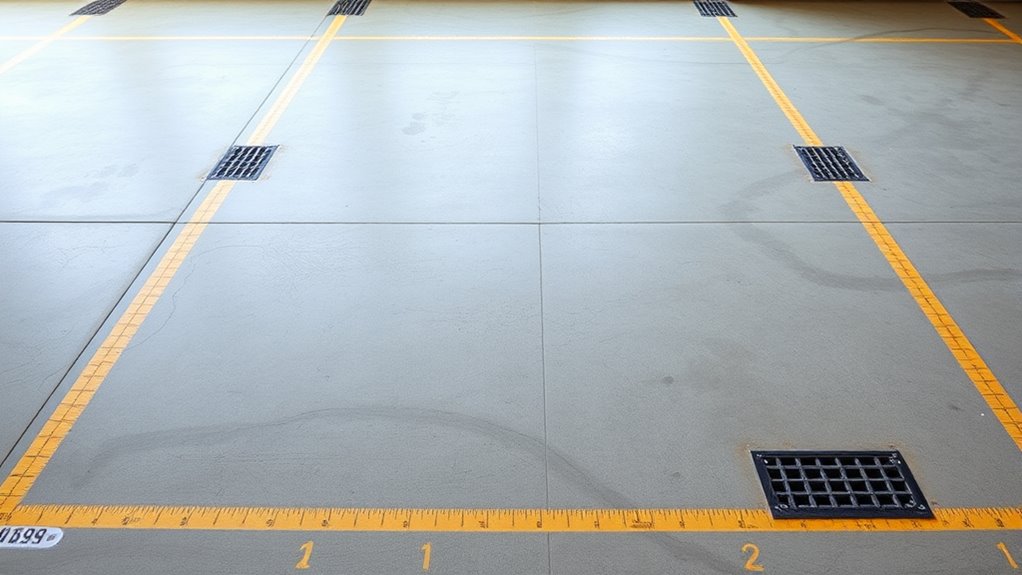
To guarantee your flooring lasts, proper subfloor preparation is essential. You need to check for subfloor moisture because excess moisture can cause warping, mold, or adhesive failure. Use a moisture meter to detect any issues before installation. Additionally, surface leveling is vital to create a smooth, even base. Uneven surfaces can lead to gaps, cracking, and reduced durability of your flooring. If you find high spots or dips, use a self-leveling compound or sanding to correct these imperfections. Properly addressing subfloor moisture and ensuring surface leveling not only protects your investment but also makes the installation process smoother. Taking these steps beforehand prevents future problems, saving you time and money while ensuring your new floor looks great and lasts for years.
Choosing the Right Flooring Materials for Your Space and Lifestyle
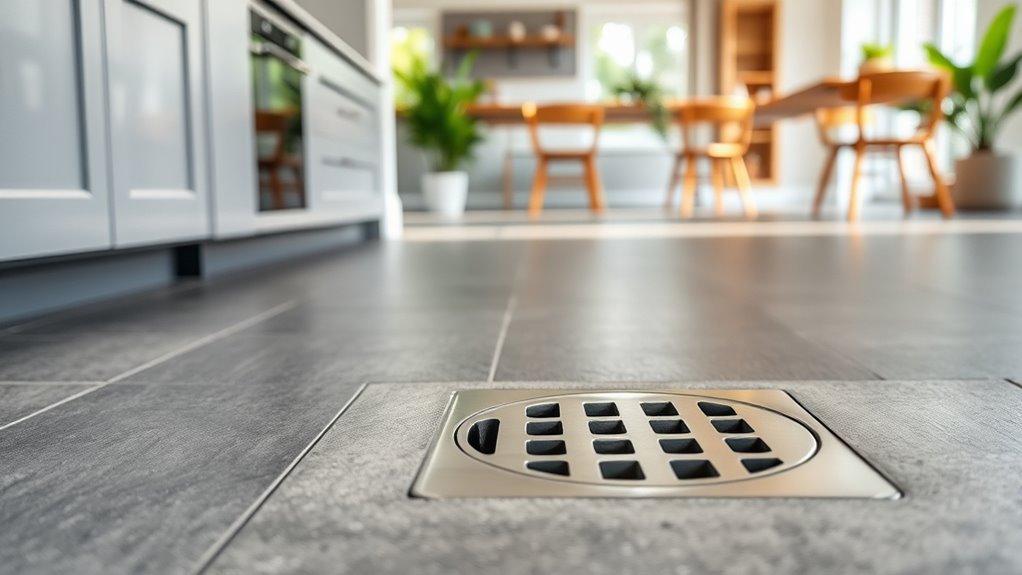
Selecting the right flooring materials depends on your space’s function and your lifestyle. Consider moisture control if you’re installing flooring in areas prone to humidity or spills, like kitchens or basements. Materials like tile, vinyl, or sealed concrete excel at preventing water damage and maintaining durability. For high-traffic zones or households with kids and pets, choose options with high material durability, such as hardwood, laminate, or stone. Think about how much maintenance each material requires and how it matches your aesthetic preferences. If you need a soft surface or warmth underfoot, carpets might work, but ensure they’re resistant to moisture and wear. Additionally, understanding the contrast ratio of your flooring choices can help you select surfaces that maintain their appeal under different lighting conditions. Making the right choice guarantees your flooring withstands daily wear and tear while aligning with your lifestyle needs.
Step-by-Step Guide to Installing Flooring Correctly
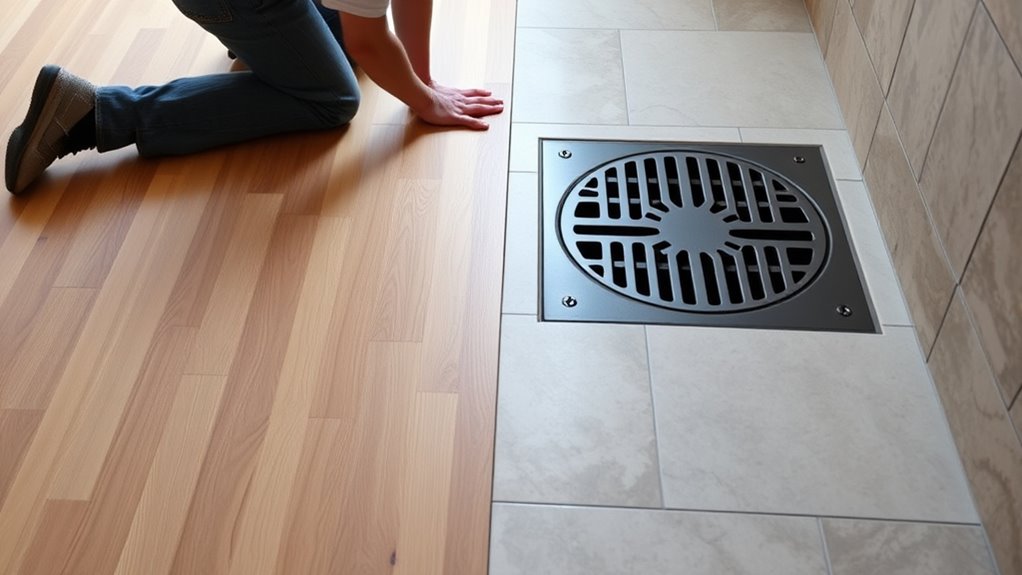
Installing flooring correctly starts with thorough preparation. Begin by checking the subfloor moisture levels, as excess moisture can cause warping or mold. Use a moisture meter to ensure the subfloor is dry and suitable for your chosen flooring material. Next, clean the surface, removing dust, debris, and any old adhesive residues. If necessary, level uneven spots with a self-leveling compound. Apply flooring adhesives evenly, following the manufacturer’s instructions, to ensure strong, durable adhesion. Carefully lay the flooring, maintaining consistent gaps for expansion if needed. Use spacers and a tapping block to fit pieces snugly together. Finally, walk on the surface gently to set the flooring, and allow the adhesives to cure fully before placing furniture. Proper preparation guarantees a long-lasting, professional-looking result.
Common Drainage Problems and How to Prevent Them
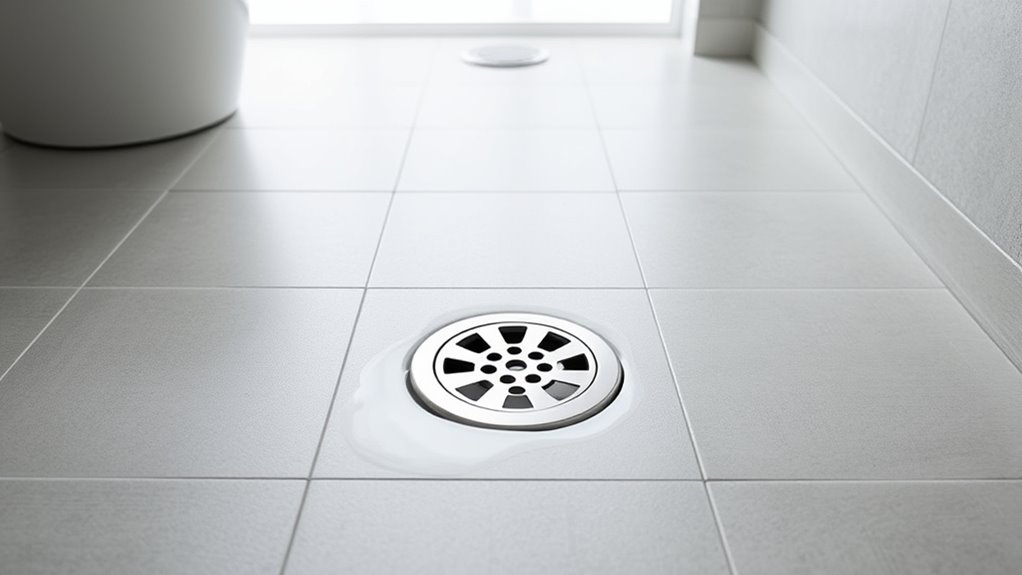
Drainage issues often stem from clogged drains, improper slope, or neglecting maintenance. You can prevent these problems by keeping drains clear, ensuring a proper slope, and performing regular checks. Addressing these points helps keep your flooring dry and free of costly damage. Additionally, inspecting and maintaining your drainage system regularly can identify potential problems before they escalate.
Clogged Drain Causes
Clogged drains often result from everyday habits and accumulated debris that restrict water flow. One common cause is subfloor moisture, which can lead to buildup inside the drain if not properly managed. Excess moisture can cause materials like flooring adhesives to break down, releasing particles that get caught in the drain. Over time, these particles, combined with hair, soap scum, and dirt, form blockages. Additionally, improper sealing around drains allows debris to enter and settle, further impeding flow. Regularly cleaning drains, avoiding the buildup of sticky substances, and controlling moisture levels beneath the floor can prevent clogs. Being mindful of how flooring adhesives and moisture interact helps you keep drains clear and functioning smoothly, avoiding costly repairs. Understanding industry trends can also help in selecting the right materials and maintenance practices to minimize drainage issues.
Proper Drain Slope
Proper drain slope plays an essential role in preventing drainage problems that can lead to costly repairs and inconvenience. When doing drain installation, guarantee the correct slope directs water efficiently toward the drain, avoiding standing water or pooling. You should check that the floor is properly leveled before installing drains, as uneven surfaces can disrupt the necessary slope. A slope of about 1/4 inch per foot is generally recommended for effective drainage. If the slope is too shallow, water may stagnate; too steep, and water may flow too quickly, causing erosion or noise. Proper floor leveling assures the drain slope remains consistent. Investing time in correct drain installation and floor leveling helps you prevent future drainage issues and extend the lifespan of your flooring and plumbing systems. Additionally, using quality floor leveling materials can enhance the stability and accuracy of the slope, ensuring long-term functionality.
Regular Maintenance Tips
Regular maintenance is essential to keep your drainage system functioning smoothly and prevent costly problems down the line. By staying proactive, you can avoid subfloor moisture issues that threaten your flooring’s durability. Regularly check for clogs, leaks, and poor drainage around drains and flooring. Keep drains clear of debris and ensure proper slope to prevent standing water. Use the table below to identify common drainage problems and their solutions:
| Problem | Cause | Prevention Tip |
|---|---|---|
| Slow draining | Blocked debris | Regularly clean drain covers |
| Standing water | Improper slope | Ensure proper drain slope |
| Moisture under flooring | Leaking pipes or poor drainage | Inspect and repair leaks promptly |
| Cracks or buckling flooring | Excess subfloor moisture | Maintain proper drainage and ventilation |
Selecting the Best Drain Types for Different Areas of Your Home
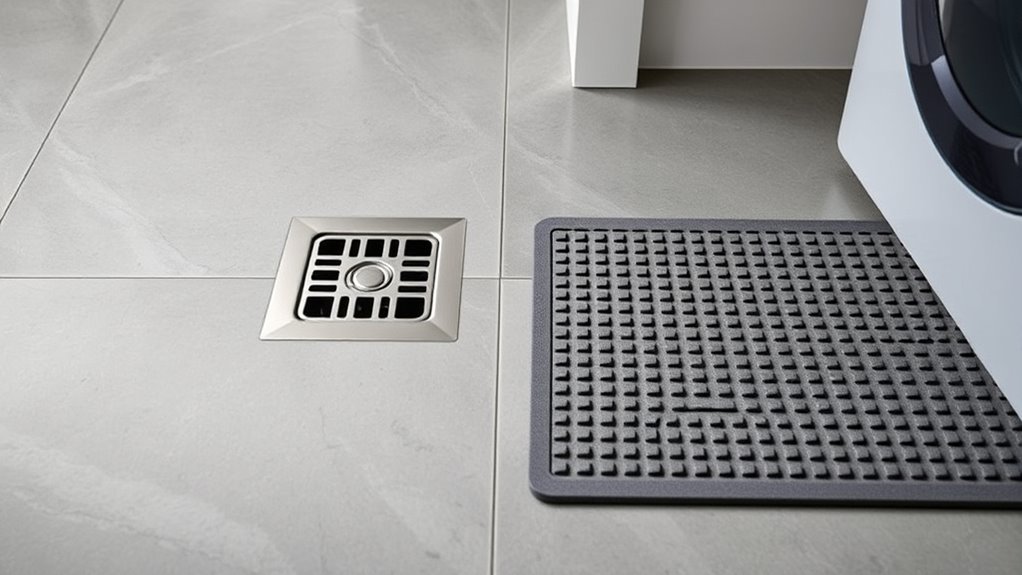
Choosing the right drain types depends on the area you’re working on. For example, kitchen drains need to handle grease and food debris, while bathroom drains must manage hair and soap residue. Outdoor drains require solutions that withstand weather and heavy runoff, so selecting the appropriate type is key to effective drainage. Incorporating proper drain selection also supports organization and space maximization by preventing clogs and ensuring smooth maintenance.
Kitchen Drain Options
When selecting a drain for your kitchen, it’s essential to take into account the area’s specific needs and usage. Kitchens experience frequent water flow, so choose a drain that prevents clogs from debris like food particles and grease. If your kitchen has tile grout, opt for a drain with a secure, tight-fitting cover to prevent grout from slipping in and causing blockages. For homes with hardwood refinishing, ensure the drain installation doesn’t compromise the floor’s integrity; a discreet, shallow setup works best to avoid damaging the finish. Consider stainless steel drains for durability and easy cleaning, especially in high-traffic areas. Properly chosen kitchen drains improve function and longevity, reducing maintenance and protecting your flooring investments.
Bathroom Drain Choices
Selecting the right bathroom drain depends on the specific area and its usage. For showers, consider a linear drain for a sleek look and better water flow, aligning with decorative trends. Bathtubs may need a standard drain, but eco-friendly options like recycled metal are gaining popularity. Vanity sinks benefit from pop-up drains, which can be customized to match your decor. Floor drains in laundry areas should be durable and easy to clean. Here’s a quick overview:
| Area | Drain Type | Eco-Friendly Options |
|---|---|---|
| Shower | Linear Drain | Recycled metal, stainless steel |
| Bathtub | Standard Drain | Eco-friendly plastics |
| Vanity Sink | Pop-up Drain | Brass with eco coatings |
| Floor in Laundry | Floor Drain | Durable, corrosion-resistant |
| General Use | Multi-purpose Drain | Modern, decorative designs |
Considering the AI Security advancements, choosing durable and reliable drain materials can help prevent unexpected issues and ensure safety in your home.
Outdoor Drain Solutions
Outdoor drain solutions vary depending on the area of your home and its specific needs. When planning your landscape design, consider how water flows across different zones, especially near patios, gardens, or walkways. A properly selected drain type prevents pooling and erosion, maintaining your yard’s integrity. For areas with outdoor lighting, ensure drains are positioned to avoid water accumulation around fixtures, protecting electrical components. In low-lying spots, a French drain or trench drain might be ideal, while surface drains work better in sloped areas. Think about integrating drains seamlessly into your landscape design for both function and aesthetics. Choosing the right drain type helps keep your outdoor space safe, dry, and visually appealing, no matter the weather or terrain. Additionally, understanding Water Parks can inspire you to create fun, water-efficient outdoor spaces that manage runoff effectively.
Proper Slope and Grading Techniques for Effective Drainage

Achieving effective drainage hinges on establishing the correct slope and grading techniques. Start by accurately measuring the slope; use a level or laser tool to ensure the proper pitch, typically a 1-2% grade. This means your surface should drop about 1/8 to 1/4 inch per foot away from structures. Proper slope measurement is essential to prevent water pooling or runoff issues. When grading, focus on creating a smooth, consistent incline that directs water toward drains or designated collection points. Avoid flat areas or sharp dips, which can cause standing water or erosion. Use grading techniques that maintain this slope across the surface, guaranteeing water flows naturally and efficiently away from your flooring or foundation. Precision here is key to long-lasting, effective drainage. Regularly inspecting your drivetrain components ensures your system remains in optimal condition for proper drainage.
Maintenance Tips to Keep Your Flooring and Drains in Optimal Condition

Regular maintenance is essential to keep your flooring and drains functioning properly and prevent costly issues. To preserve your flooring patterns, regularly sweep and clean to remove dirt and debris that can cause damage or uneven wear. Pay attention to grout lines and seams, ensuring they remain sealed and intact. For drains, inspect and clear out any blockages to maintain ideal flow. Keeping drain aesthetics in mind, use gentle cleaning solutions that won’t discolor or damage surrounding surfaces. Avoid harsh chemicals that can deteriorate materials. Regularly check for signs of water pooling or damage near drains and flooring edges. Proper upkeep ensures your flooring retains its appearance and functionality, while your drains stay clear and efficient, saving you time and money in the long run. Additionally, understanding the importance of air quality and pollutant control can help you make better choices in cleaning and maintenance practices, reducing potential health risks associated with poor indoor air quality.
Expert Tricks for Seamless Transitions and Finishing Touches
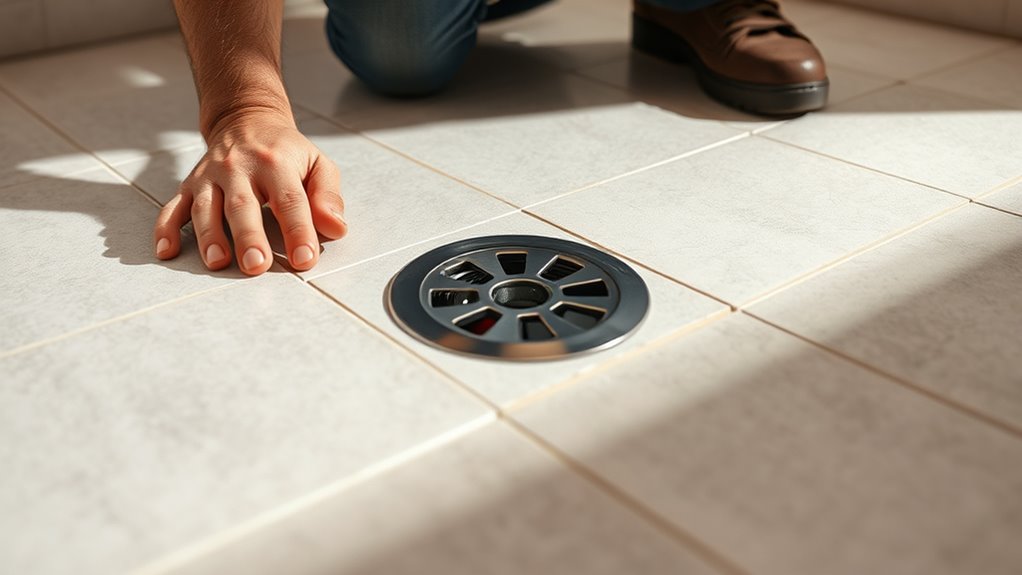
Seamless progressions and polished finishing touches can elevate the overall look of your flooring project, making it appear professionally designed. To achieve this, pay close attention to transitions between different flooring types or rooms. Use expert tricks like leveling uneven surfaces and aligning patterns precisely. Incorporating subtle design details enhances the flow and creates a unified aesthetic. Consider this table for key finishing touches:
| Tip | Description | Benefits |
|---|---|---|
| Transition Strips | Hide gaps and create smooth flow | Neat, professional look |
| Consistent Grain/Pattern | Match patterns for continuity | Visual harmony |
| Precise Measurements | Ensure accurate cuts and placements | Seamless transitions |
Mastering these techniques ensures your flooring and drains look flawless, with seamless transitions and perfect finishing touches that impress.
Recognizing and Fixing Flooring and Drain Issues Before They Worsen
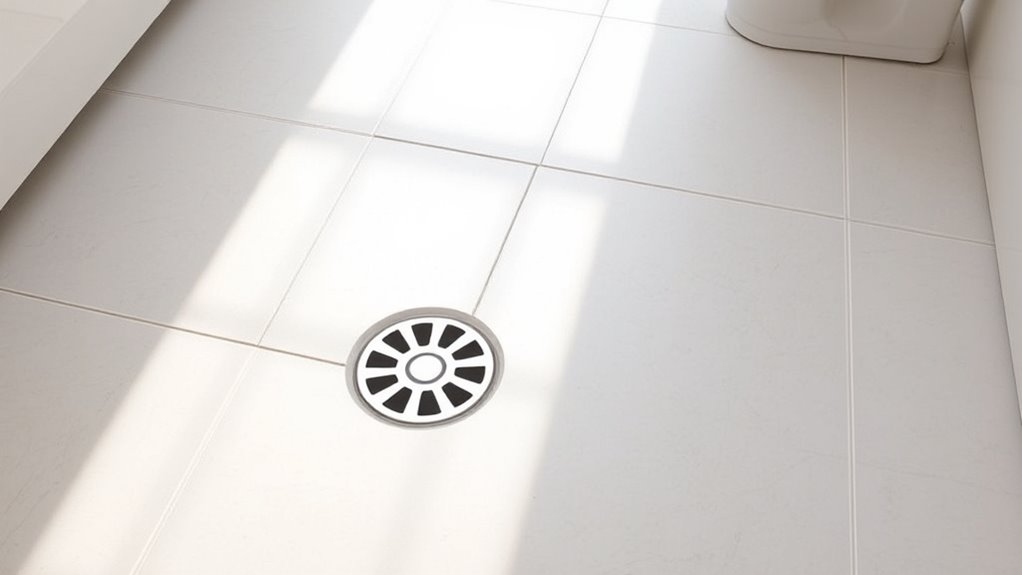
Early detection of flooring and drain issues is crucial to prevent costly repairs and extensive damage. Keep an eye out for signs like uneven surfaces, persistent dampness, or musty odors, which may indicate underlying problems. Proper humidity control helps reduce excess moisture, preventing mold growth that can weaken your flooring and affect drain performance. Regular inspections allow you to spot small issues before they escalate, such as minor leaks or water pooling around drains. Address problems promptly by sealing leaks, improving ventilation, or replacing damaged materials. Staying proactive not only preserves your flooring’s integrity but also minimizes health risks associated with mold. By recognizing these early warning signs and taking swift action, you ensure your space remains safe, dry, and well-maintained.
Frequently Asked Questions
How Can I Tell if My Subfloor Is Properly Prepared?
You can tell if your subfloor is properly prepared by checking for excessive moisture, which can cause future issues. Use a moisture meter to assess the subfloor’s moisture levels; they should be within recommended ranges. Also, inspect for any signs of damage or unevenness. If you find issues, consider subfloor repair before installing new flooring. Proper preparation guarantees durability and prevents costly problems down the line.
What Are the Best Tools for Precise Drain Installation?
Precise drain installation demands dependable tools. You’ll want a high-quality level for perfect positioning, a laser measure for exact measurements, and a drain snake or auger for clearing obstructions. Calibrate your tools regularly to guarantee accuracy, and conduct drainage testing to confirm proper flow. These tools help you achieve seamless slope and secure sealing, preventing leaks and water damage. With the right gear, you’ll install drains confidently and correctly every time.
How Often Should Flooring and Drains Be Inspected?
You should inspect your flooring and drains at least twice a year to catch issues early. Following a regular inspection schedule helps prevent costly repairs and water damage. During inspections, look for cracks, leaks, or signs of wear. Use maintenance tips like cleaning drains regularly and checking for proper drainage. Staying proactive guarantees your flooring remains durable and your drains function smoothly, giving you peace of mind and saving money in the long run.
Are There Eco-Friendly Flooring Options Available?
Yes, eco-friendly flooring options are available. You can choose sustainable options like bamboo, cork, reclaimed wood, or recycled materials, which reduce environmental impact. These eco-friendly materials are durable, stylish, and healthier for your home. By selecting sustainable options, you support environmental conservation and create a healthier indoor space. Explore these alternatives to make smarter, greener choices for your flooring needs.
What Signs Indicate Drainage Problems Before Major Damage Occurs?
Think of your drainage system as a nervous system; early signals warn you of trouble. If you notice water pooling on your floor or strange gurgling sounds, it’s a sign of clogged pipes or slow drainage. These issues often occur before major damage, so keep an eye out for persistent damp spots or foul odors. Addressing these signs early helps prevent costly repairs and keeps your home flowing smoothly.
Conclusion
By following proper flooring and drainage techniques, you can prevent costly repairs and enjoy a durable, beautiful space. Did you know that poorly installed flooring and drainage issues account for nearly 30% of home repairs? Staying proactive with regular maintenance and correct installation guarantees your home stays safe and comfortable for years to come. Don’t guess—get it right the first time and protect your investment!
